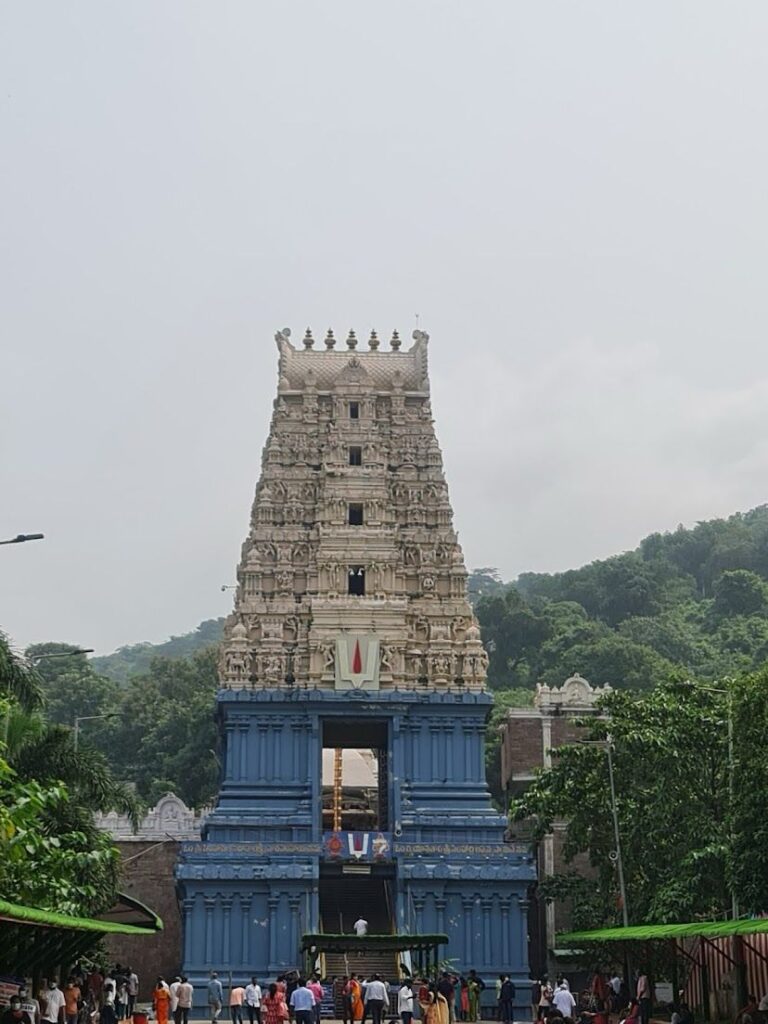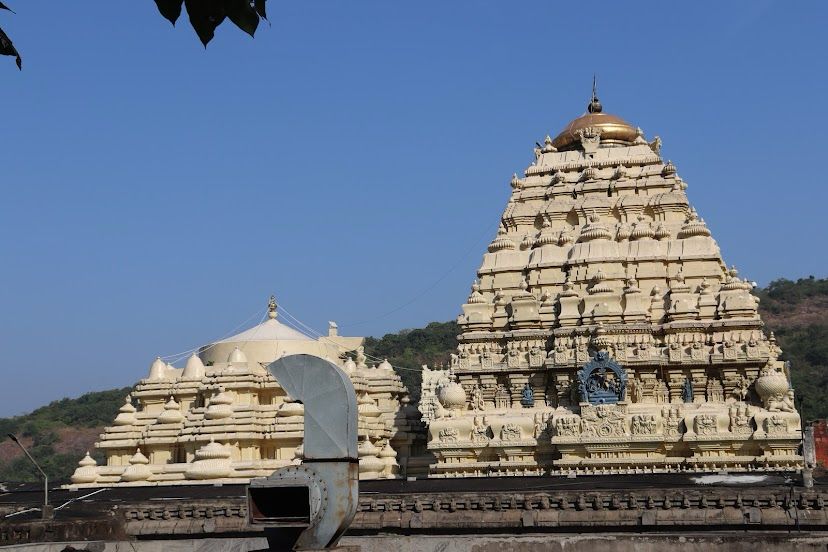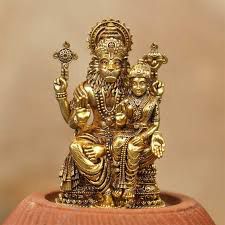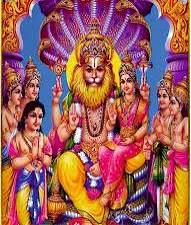The Majestic Simhachalam Temple: A Spiritual Haven in Andhra Pradesh
By Loknath Mishra
Located in the picturesque town of Simhachalam, about 16 kilometers from Visakhapatnam, the Simhachalam Temple is one of the most revered and famous Narasimha temples in Andhra Pradesh. This ancient temple, nestled in the midst of the Eastern Ghats, is a testament to the region’s rich cultural heritage and spiritual significance.
History and Legend

The Simhachalam Temple has a rich history that dates back to the 11th century. According to legend, the temple was built by the Chalukya king, Sri Krishna Deva Raya, who was a devout follower of Lord Narasimha. The temple’s presiding deity, Lord Varaha Narasimha, is said to have been installed by the king himself.
Architecture and Sculpture
The Simhachalam Temple is a masterpiece of architectural excellence, showcasing the unique style of the Chalukya dynasty. The temple’s sanctum sanctorum, built on a hilltop, is surrounded by a series of concentric walls, adorned with intricate carvings and sculptures. The temple’s exterior walls feature stunning sculptures of various deities, including Lord Narasimha, Lord Varaha, and Lord Venkateswara.
The Presiding Deity
The presiding deity of the Simhachalam Temple, Lord Varaha Narasimha, is a unique and awe-inspiring idol. The idol, measuring about 5 feet in height, depicts Lord Narasimha in his Varaha incarnation, with the body of a boar and the face of a lion. The idol is adorned with intricate carvings and ornaments, adding to its majesty and grandeur.

Festivals and Celebrations
The Simhachalam Temple is renowned for its vibrant festivals and celebrations, which attract devotees from all over the world. Some of the most notable festivals include:
- Chandana Yatra: A 40-day festival celebrated during the summer months, where the idol of Lord Varaha Narasimha is adorned with sandalwood paste.
- Narasimha Jayanti: A grand festival celebrated on the occasion of Lord Narasimha’s birthday, marked by special pujas, processions, and cultural programs.
Spiritual Significance
The Simhachalam Temple is a sacred site that embodies the spiritual essence of Lord Narasimha. The temple’s serene atmosphere, stunning architecture, and vibrant festivals create a unique spiritual experience that draws devotees closer to the divine.
In conclusion, the Simhachalam Temple is a majestic and revered Narasimha temple in Andhra Pradesh, renowned for its stunning architecture, vibrant festivals, and spiritual significance. This ancient temple is a testament to the region’s rich cultural heritage and a must-visit destination for anyone seeking a deeper connection with the divine.
The Sacred Temples of Mangalgiri: Unveiling the Mystique of Narasimha Swamy and Panakala Narasimha Swamy
Mangalgiri, a picturesque town in the Guntur district of Andhra Pradesh, is renowned for its stunning temples, rich history, and spiritual significance. Among the town’s many sacred sites, the Narasimha Swamy Temple and the Panakala Narasimha Swamy Temple stand out for their unique legends, stunning architecture, and vibrant festivals.
Narasimha Swamy Temple (Lakshmi Narasimha Swamy Temple)
Located on the sacred Mangalgiri Hill, the Narasimha Swamy Temple is a revered site dedicated to Lord Narasimha, the half-man, half-lion incarnation of Lord Vishnu. This ancient temple, built in the 14th century, is a masterpiece of architectural excellence, showcasing the unique style of the Vijayanagara dynasty.
- Legend: According to legend, the temple was built by the Vijayanagara king, Sri Krishnadeva Raya, who was a devout follower of Lord Narasimha. The temple’s presiding deity, Lord Narasimha, is said to have been installed by the king himself.
- Architecture: The temple’s stunning architecture, with its intricate carvings and sculptures, is a testament to the region’s rich cultural heritage. The temple’s exterior walls feature stunning sculptures of various deities, including Lord Narasimha, Lord Venkateswara, and Lord Ganesha.
- Festivals: The temple celebrates various festivals throughout the year, including the annual Brahmotsavam, which attracts devotees from all over the world.
Panakala Narasimha Swamy Temple
Located within the Lakshmi Narasimha Swamy Temple complex, the Panakala Narasimha Swamy Temple is a unique and fascinating site. This small temple, dedicated to Lord Narasimha, is famous for its unusual tradition of offering panakam (a sweet, jaggery-based drink) to the deity.
- Legend: According to legend, the temple was built by the local villagers, who were devotees of Lord Narasimha. The temple’s presiding deity, Lord Panakala Narasimha Swamy, is said to have been installed by the villagers themselves.
- Architecture: The temple’s architecture, although smaller in scale, is similar to that of the Lakshmi Narasimha Swamy Temple, with intricate carvings and sculptures adorning its walls.
- Festivals: The temple celebrates various festivals throughout the year, including the annual Brahmotsavam, which attracts devotees from all over the region.
Spiritual Significance
Both the Narasimha Swamy Temple and the Panakala Narasimha Swamy Temple are sacred sites that embody the spiritual essence of Lord Narasimha. The temples’ serene atmosphere, stunning architecture, and vibrant festivals create a unique spiritual experience that draws devotees closer to the divine.
In conclusion, the Narasimha Swamy Temple and the Panakala Narasimha Swamy Temple are two sacred sites in Mangalgiri that are steeped in history, legend, and spiritual significance. These temples are a must-visit destination for anyone seeking a deeper connection with the divine and a glimpse into the rich cultural heritage of Andhra Pradesh.
The Enduring Legacy of Prabhu Narasimha: Uniting the People of Odisha and Andhra Pradesh
Prabhu Narasimha, the half-man, half-lion incarnation of Lord Vishnu, has been a revered deity in both Odisha and Andhra Pradesh for centuries. His influence on the people of these two states has been profound, shaping their culture, traditions, and spiritual practices.
Cultural Significance
In both Odisha and Andhra Pradesh, Prabhu Narasimha is revered as a symbol of divine protection, strength, and courage. His legend has inspired countless literary works, art forms, and cultural traditions. The people of both states celebrate various festivals and rituals in honor of Prabhu Narasimha, including the Narasimha Chaturdashi and the Narasimha Jayanti.

Spiritual Influence

Prabhu Narasimha’s spiritual influence on the people of Odisha and Andhra Pradesh is profound. He is revered as a deity who embodies the qualities of compassion, forgiveness, and selfless service. His teachings, as embodied in the Bhagavata Purana and other scriptures, have inspired countless devotees to follow the path of devotion, spirituality, and self-realization.
Unifying Factor
Despite the geographical and cultural differences between Odisha and Andhra Pradesh, Prabhu Narasimha has been a unifying factor, bridging the gap between the two states. His worship and reverence have transcended regional and linguistic boundaries, creating a sense of shared cultural heritage and spiritual identity.
Influence on Literature and Art
Prabhu Narasimha’s influence on literature and art in both Odisha and Andhra Pradesh has been significant. His legend has inspired countless literary works, including the famous Odia epic, the “Narasimha Purana,” and the Telugu epic, the “Narasimha Charitra.” His image has also been depicted in various art forms, including sculptures, paintings, and dance.
Conclusion
In conclusion, Prabhu Narasimha’s influence on the people of Odisha and Andhra Pradesh has been profound, shaping their culture, traditions, and spiritual practices. His legacy continues to inspire and unite the people of both states, creating a sense of shared cultural heritage and spiritual identity.
The Gajapati rulers of Kalinga, specifically Odisha, did indeed construct several Narasimha temples in both Odisha and Andhra Pradesh (AP). One notable example is the Simhachalam Temple, also known as Varaha Lakshmi Narasimha Temple, located in Visakhapatnam, AP. This temple was initially built in the 11th century by the Gajapati rulers of Odisha and later renovated by the Vengi Chalukyas and Narasimha I of the Eastern Ganga dynasty in the 13th century .

The Gajapati Empire, which ruled over a vast territory stretching from the Ganges to the Kaveri, was known for its patronage of Vaishnavite Hinduism and the construction of many temples dedicated to Lord Vishnu, including those featuring his Narasimha avatar .
In Odisha, the Gajapati rulers constructed several temples, including the famous Jagannath Temple in Puri, which became a center for artistic and cultural expression during their rule .The Narasimha temples built by the Gajapati rulers in both Odisha and AP stand as testaments to their devotion to Lord Vishnu and their architectural and cultural achievements.
